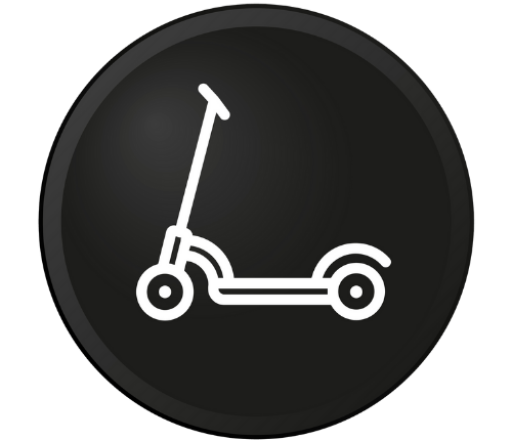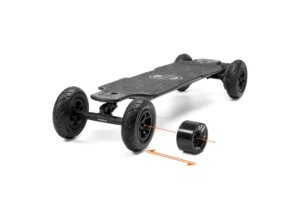Do you love hitting the skate park with your scooter but struggle to pull off those gnarly tricks? Or you’re just starting and want to ensure you have the right equipment for maximum performance.
Whatever your level of expertise, understanding scooter deck size and weight is crucial in improving your overall ride.
In this blog post, we’ll dive into everything you need about scooter decks – from choosing the right size and weight for your riding style to tips on maintaining and upgrading your deck for ultimate precision and control. Let’s get rolling!
Introduction to Scooter Decks
A scooter deck is part of the scooter that you stand on. It is also sometimes referred to as the “foot platform.” The deck is one of the essential parts of a scooter because it supports your weight and helps you perform tricks.
A few things to consider when choosing a scooter deck: are size, weight, and material.
Size: Decks come in different sizes, measured by width and length. Width is measured from one end of the deck to the other, and height is measured from the front of the deck to the back. Most decks are 19-22″ long and 4-5″ wide. Beginner riders may choose a shorter or narrower deck for easier maneuverability. More experienced riders may prefer a longer or broader deck for stability and more grind space.
Weight: Decks can range from 1-2 pounds to 4 pounds or more. Heavier decks tend to be made of metal (aluminum or steel), while lighter decks are usually made of plastic (polycarbonate). The deck’s weight will affect how easy it is to ride and perform tricks – lighter decks are easier to maneuver but may be less durable, while heavier decks are more stable but harder to control.
Material: Decks are typically made from aluminum, steel, or plastic (polycarbonate). Aluminum decks are lightweight but strong, making them an excellent street-riding choice. Steel decks are the heaviest but offer more stability and durability, making them suitable for park or ramp riding. Plastic decks are the lightest and least expensive but may be less durable over time.
Whatever kind of scooter deck you choose, ensure it fits your weight and riding style. This will help ensure a safe, enjoyable experience while riding your scooter!
Factors in Choosing the Right Deck Size and Weight
There are a few key factors to consider when choosing the right deck size and weight for your scooter. The first is the riding you’ll be doing. If you’re mostly doing street riding, you’ll want a lighter deck that’s easy to maneuver. If you plan on doing more tricks and jumps, you’ll want a heavier deck that can handle the impact.
The second factor to consider is the width of the deck. A more expansive deck will be more stable but also harder to maneuver. A narrower deck will be easier to handle but less stable. You’ll need to find a balance that works for you based on your riding style and what feels comfortable.
Finally, consider the weight limit of the deck. Heavier riders will need a sturdier and heavier deck, while lighter riders can get away with a more lightweight deck. Pay attention to the weight limit so you don’t end up with a scooter that’s too weak or too strong.
Pros and Cons of Different Sizes and Weights
When choosing a scooter deck, size is one of the most important factors to consider. The width and length of the deck will affect everything from stability to maneuverability. But what’s the ideal scooter deck size, and how does the weight come into play?
Here’s a look at the pros and cons of different sizes and weights when it comes to scooter decks:
Smaller Decks:
– More maneuverable and easier to control
– Great for tricks and technical riding
– Can be more comfortable for smaller riders
Cons:
– Not as stable as larger decks
– Might feel cramped for larger riders
– It can be more challenging to land tricks on smaller decks
Larger Decks:
– More stable and better for high speeds
– Great for beginners or riders who want a more relaxed ride
– Can accommodate larger riders comfortably
Cons:
– Not as maneuverable as smaller decks
– Can feel bulky and cumbersome for smaller riders
– Might be more difficult to perform tricks on larger decks
Weight:
– Heavier decks are usually more durable and better for downhill or downhill freeriding
– Lighter decks can be easier to maneuver, which makes them ideal for tricks and technical riding
Cons:
– Heavier decks can be more challenging to control, particularly at high speeds
– Lighter decks may not be as durable as heavier ones
Tips for Improving Performance with the Right Scooter Deck
If you want to improve your scooter performance, one of the best places to start is with your deck. The right scooter deck can make a big difference in how your scooter rides, feels, and handles. Here are a few things to keep in mind when choosing a deck:
Size: The size of your deck will affect the balance and stability of your scooter. An enormous deck will give you more room to move around and will be more stable, while a smaller deck will be more agile but may be less stable. Weight: The weight of your deck will also affect performance.
Heavier decks will be more durable but harder to maneuver, while lighter decks will be easier to work but may need to be more stable. Material:
The material of your deck will affect both the weight and the flexibility of your scooter. Softer materials like foam or plastic will be lighter and more flexible, while more complex materials like wood or metal will be heavier and more rigid.
Consider these factors when choosing a deck, and you’ll be sure to find one that improves your scooter’s performance.
Deck Size and Weight Buyer’s Guide
When shopping for a new scooter deck, it is essential to keep in mind the deck’s size and weight. The deck’s size will affect the scooter’s overall performance, as well as how comfortable it is to ride. The importance of the deck will also affect performance and how easy it is to carry around.
Size
The size of the deck is measured in width and length. The deck should be expansive enough so that your feet can fit comfortably side-by-side on the balcony. If the deck is narrow enough, your feet may feel cramped when riding. On the other hand, if the deck is too broad, controlling the scooter may be challenging.
The deck should be long enough so that your feet can reach all four corners of the deck while riding. If the deck is extended, you may shift your feet around frequently while riding. If the deck is shorter, it may be easier to maneuver around tight corners.
Weight
The weight of a scooter deck can vary depending on the materials used and the manufacturing process. Heavier decks tend to be made from sturdier materials, such as aluminum, while lighter decks are often made from plastic or carbon fiber composites. More serious decks are also usually thicker than lighter decks.
While a more severe deck may be more durable, it can also make tricks more challenging to perform and add to the scooter’s overall weight. A lighter deck is usually easier to control and can make tricks easier to perform, but it may not be as durable as a heavier one.
Conclusion
In conclusion, scooter decks come in various sizes and weights designed to meet different riders’ needs. Choosing the right size and weight for your deck should be based on the riding you intend to do and what fits your body type. Now that you understand more about scooter decks, head onto the streets and confidently hit those tricks!



